When it comes to popular SUVs, one of the quintessential family picks is the Honda Pilot. It offers loads of practicality and reliable V6 performance, but there’s another option in the Honda lineup that’s somewhat smaller but overlaps significantly: the Passport. While it doesn’t have a third row like the Pilot, it’s been completely redesigned for 2026, and is boasting some serious reasons why you might consider picking it over the default choice Pilot. So, who wins in a 2026 Honda Passport vs. 2025 Honda Pilot battle? Well, today you’re going to find out!
Pricing and Equipment
We’re going to go over all the features, performance, and space differences throughout this comparison, but as always, let’s start with a quick pricing breakdown.
To show off the best both models have to offer we have the loaded examples. For Pilot, that is the Elite trim, which after destination comes to a final price of $54,985.
Pilot Elite AWD: $53,080 | Options: +$455 | Destination: $1,450 | Total: $54,985
For the Passport, its top trim is also an Elite, but its only available in combination with the added capability of the TrailSport. You might be surprised to find out that this TrailSport Elite is priced extremely similarly, with a final price after destination of $54,355.
Passport TrailSport Elite AWD: $52,450 | Options: +$455 | Destination: $1,450 | Total: $54,355
Exterior Design
Now before we get in too deep into this comparison, I want to mention that the Honda Passport is based on the same platform as the Honda Pilot for those that don’t already know. That means they’ll share quite a few elements in common, however, one of the biggest areas they diverge from one another is in their exterior designs. The Passport is wider than Pilot, and has a more rugged overall mission, which is why it has a boxier, more rugged grille compared to the simple and classy finish on the Pilot.
For lighting, both have rectangular LED reflector headlights and signature DRL’s. The Passport’s DRLs are a distinct amber color, and both also have LED fog lamps.
Moving to the side, you’ll really start to see some differences. The Passport has a very boxy shape and comes in a whopping 8 inches shorter than the Pilot. That size difference surprisingly doesn’t impact interior space as much as you’d think, but we’ll dive more into that later in the comparison.
Length: 199.9-inches (Pilot) | 191.5-inches (Passport)
For wheels, we also have some differences. The street-focused Pilot is rocking 20-inch contrast alloy wheels, while the largest size you can get on the Passport is 18 inches. So, if you like bigger wheels then pick the Pilot, but if you like your luxury paired with tougher all-terrain tires, then the Passport TS Elite is the way to go. More on that later.
Both have rugged matte black wheel surrounds, with the Passport’s being a little more pronounced, and as we head around to the back, once again the Passport looks a little tougher. The features in the back are the same, minus an LED reverse light on the Passport, and for towing, both can handle the same 5,000 pounds.
Towing (max): Passport: 5,000 lbs | Pilot: 5,000 lbs
Additional Features
Now checking out some of the individual features, both of their mirrors have heating, blind spot monitoring, power-folding and even auto-dimming.
Being safe is a priority for anyone looking to buy SUVs like these, and indeed they are including every single active safety feature as standard equipment. That means they even have traffic jam assists, and, as expected, warranty coverage is also the same.
Both: Warranties: Basic Warranty: 3yr/36k mi | Powertrain: 5yr/60k mi | Complimentary Maintenance: 1yr/12k mi
Now the more interesting differences are on the inside, so now let’s move on to that.
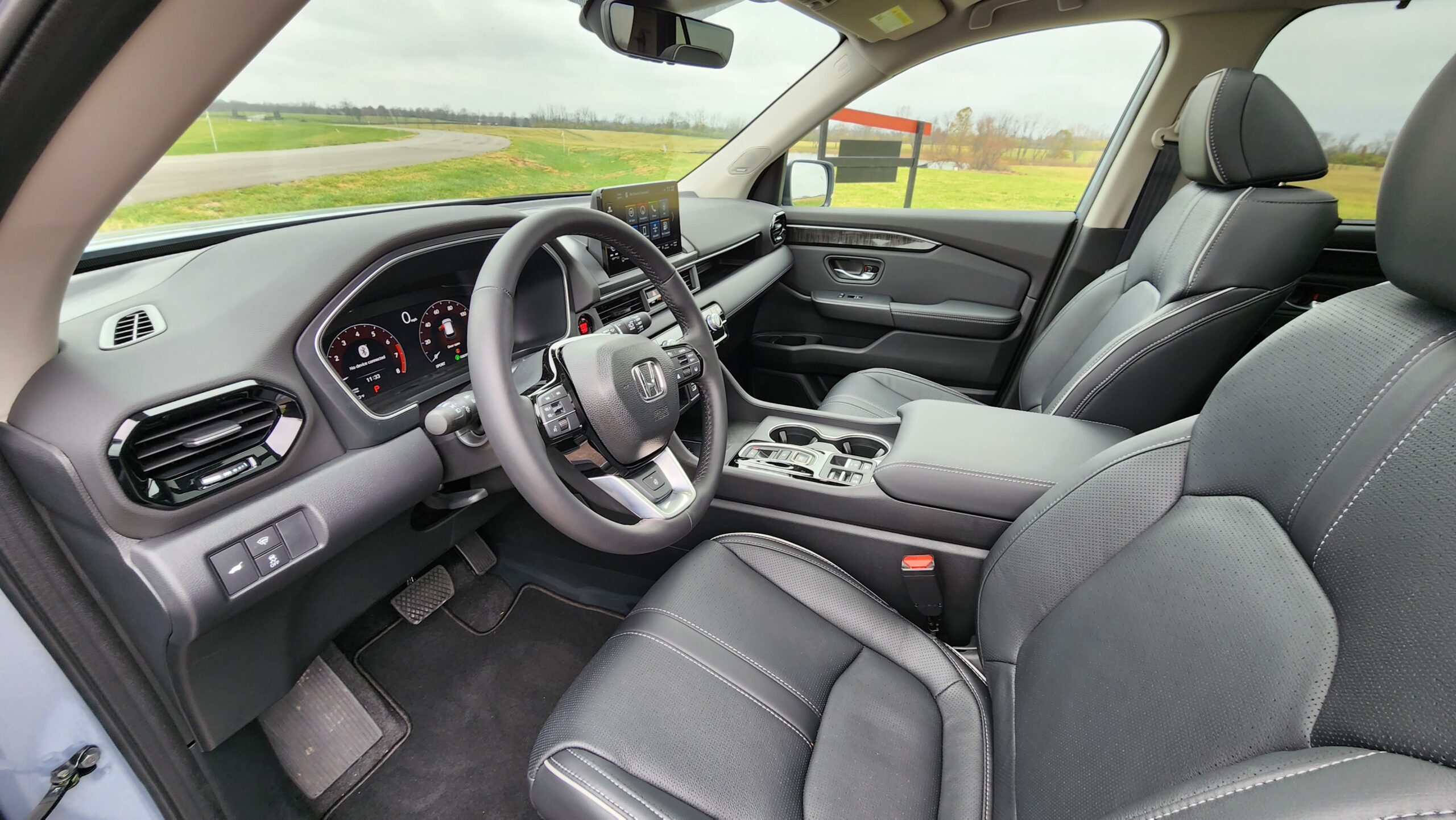
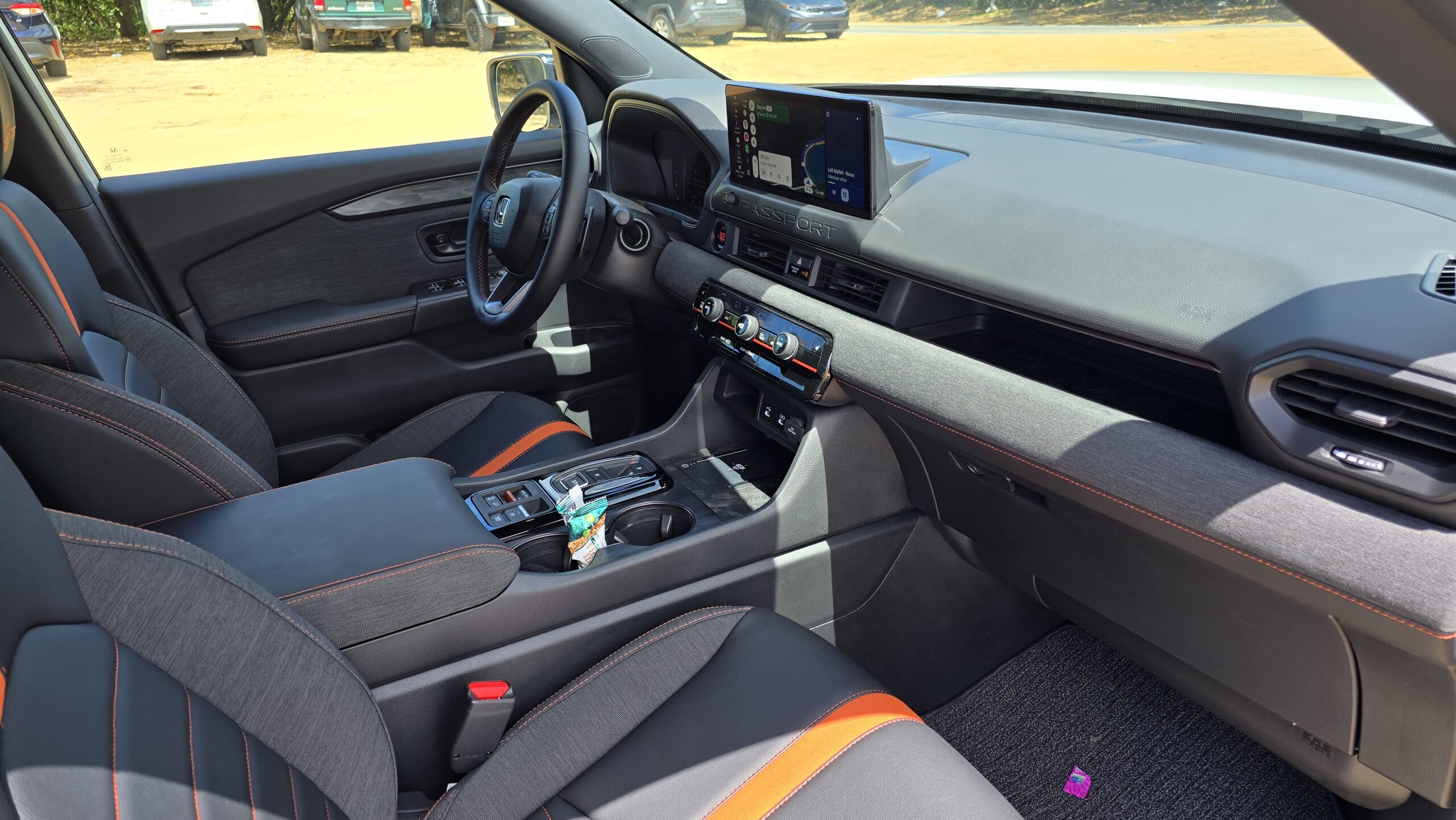
Interior Design
Alright, let’s move into the cabins. Approaching the SUV’s, they have the same key fobs for their smart entry systems, and remote start is built-in, subscription-free for life.
Now once we open the doors, you’ll notice that they are very similar to one another visually. But the details are what distinguish these models, and the trim level options are particularly important here. Passport is only available in 3 trims, 2 of which are TrailSport and TrailSport Elite. On the Pilot, you have far more trims to pick from but there is no way to combine TrailSport and Elite together. Depending on your preferences, you might want them to be combined or separated but just knew that each has their own way of doing things.
Getting into the seats, we have 10-ways of adjustment, heating, ventilation, and memory, plus they’re finished in real leather upholstery. You’ll notice the shape and stitching details are also the same, but Passport includes some additional TrailSport branding.
Now let’s climb inside and talk about the rest of the materials you will find inside. As expected, these two interiors mirror each other closely and that does indeed mean their materials are the same as well. We have lots of soft touch plastics, faux trim pieces, and padded leatherette where your arm rests. Neither has the advantage over the other and they are pretty nicely done.
After startup, you’ll see 10.3-inch digital gauge clusters on both with slightly different information in them, but more importantly, the Pilot Elite includes a head up display which is oddly something missing from all Passports.
Pulling back, they have rain-sensing wipers and heated steering wheels with manual adjustment.
Storage and Technology
But another area of importance is interior storage, since these are family SUVs after all. We loaded the consoles down with donuts for our Car Confections donut volume test and both fit a whopping 19 donuts inside. That’s extremely impressive for their segments, and in addition, they include passenger storage shelves, and large bins with wireless phone chargers in the front.
Shifter-wise, they have the signature Honda push-button setup and feature a 360-degree camera when in reverse.
They also both have 3-zone automatic climate systems, with the same easy-to-use and premium feeling physical knobs.
And speaking of knobs, that now brings us to the volume knobs. Let’s give the audio systems a sample. As you would probably expect, they sound very similar being of the same brand and having the same 12 speaker count.
Pilot: 12-speaker Bose Premium sound system
Passport: 12-speaker Bose Premium Audio
But now it’s time to look at the elephant in the room: the main infotainment screens. Since almost everything else in the cabins are the same, you’d expect their main screens to be as well. However, that’s actually not the case and the all-new Passport is including a larger 12.3-inch screen compared to the Pilot’s 9-inch screen. Not only is that a significant size advantage, for now at least, but also it has different software with Google built in. That means you have things like Google assistant and Google maps built natively into the system compared to the Pilot’s Garmin based system.
We do expect this to be added to the Pilot eventually, but that’s just us speculating at the time of this video. Regardless, both have wireless Apple CarPlay and Android Auto.
Last but certainly not least for the front of the interiors, both models have auto-dimming mirrors, but only the Pilot includes HomeLink garage remotes unless you want to spend $430 more for that on the Passport.
Both have large panoramic sunroofs.
LOOKING TO BUY One OF THEse VEHICLES?
A smart next step would be to check our Car Quote Tool. This tool will connect you with local dealerships in your area to get you the BEST price, access to INVOICE PRICING information, and a monthly payment calculator. Get dealerships to compete for your business!
Rear Seats and Cargo
As has been the trend in the video so far, their second rows are nearly identical to one another. So first off, let’s talk space. They come in at an impressive 41 inches of legroom and over 40 inches of headroom, which makes them some of the biggest in each of their respective segments.
- Passport: Legroom: 40.9-inches | Headroom: 40.7-inches
- Pilot: Legroom: 40.8-inches | Headroom: 40.2-inches
And as far as the features back here, they have an identical list of niceties to ward off any complaints. There are rear climate controls, vents, USB ports, household power outlets, sunshades, and the seats themselves are heated.
But the Pilot does have a trick up its sleeve Passport can’t get. And that’s this multi-function middle seat that folds down to provide a center armrest and storage cubby, plus can be fully removed to create captain’s chairs. That’s a great feature for family comfort and customizability.
Let’s head to the next row of seats. Well… in the Pilot at least. Like we said at the beginning, these two Honda SUVs are in different segments, and because of that, the Passport does not have a third row. That means the Pilot will be able to seat 3 more people overall and this is one of the biggest reasons why you’d buy Pilot over Passport.
Now Honda is great about making the most out of available space and that will shine as you open up their power tailgates. These SUVs are two of the largest options in their respective segments, and even despite the Passport being about 8 inches shorter than Pilot, it’s not much smaller in overall cargo capacity. Behind the second row, the Pilot comes in about 9% larger than the Passport, but as a maximum, that percentage shrinks down to only 3.7% larger which isn’t enough of a difference to award a point.
Passport: 2nd Row: 44.0 cu.ft | MAX: 83.8 cu.ft
Pilot: Behind 3rd row: 18.6 cu.ft | Behind 2nd row: 48.5 cu.ft | MAX: 87.0 cu.ft
The Pilot’s third row is manual folding, both have spare tires, and they even have the walk away auto close tailgate that we’ve seen on many Acura products.
But that’s it for the interiors, so now let’s get them out on the streets and see how they perform behind the wheel!
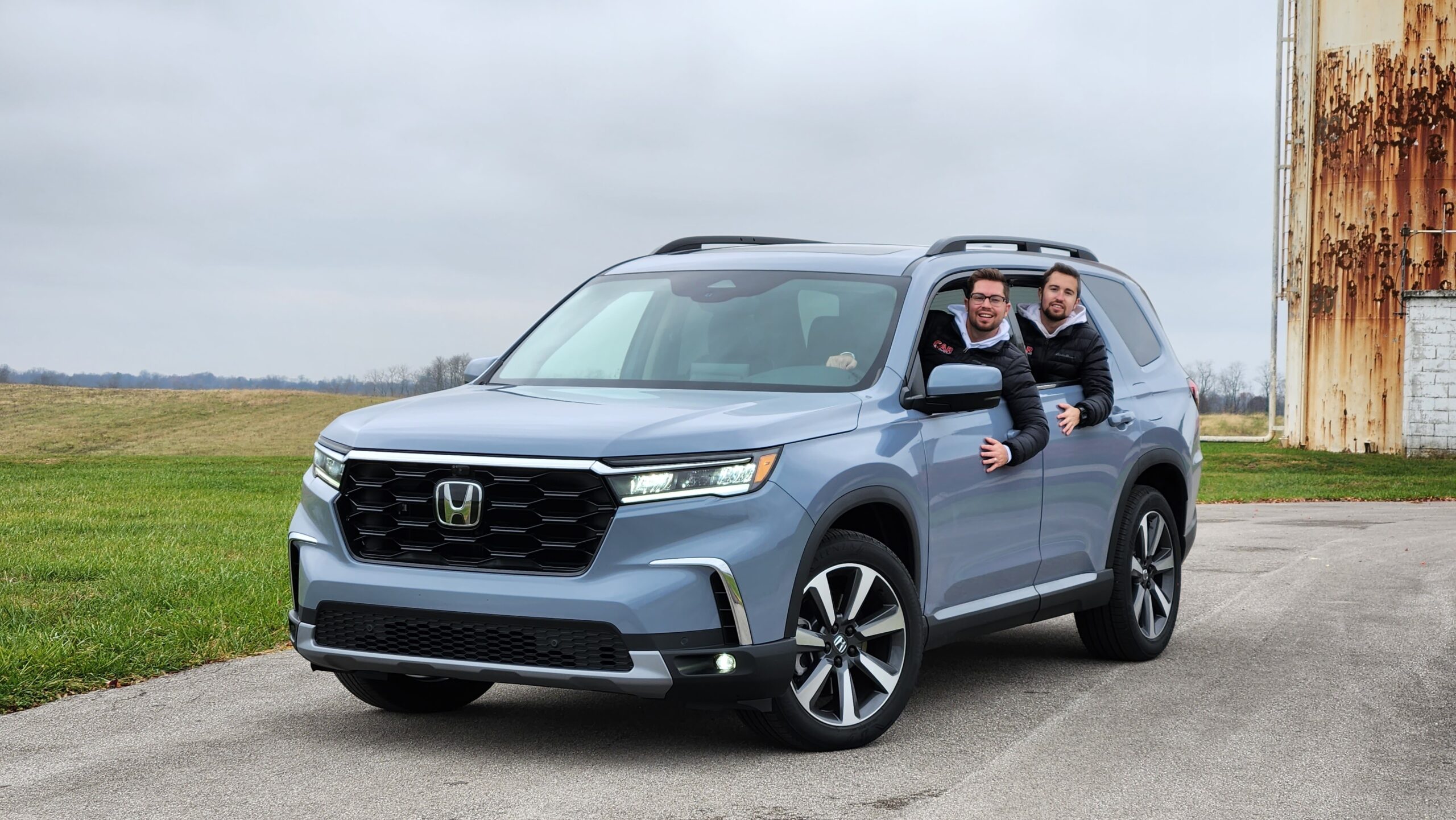
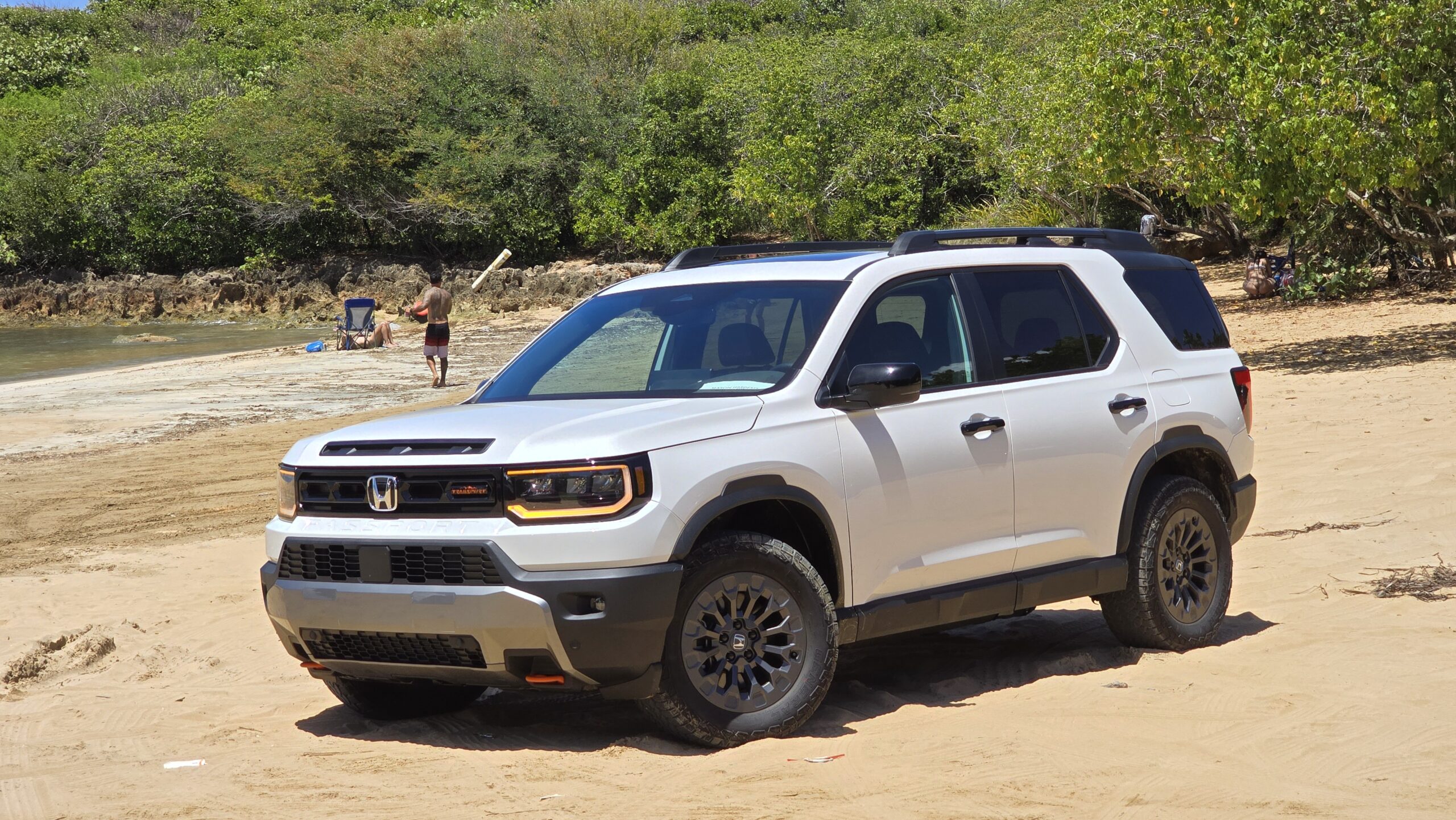
Powertrains
So, V-6 lovers rejoice because these are two family SUVs that have resisted the urge to downsize and complicate their engines thus far. Instead, they both have the same 3.5L naturally aspirated V6 engine making 285 horsepower and 262 lb. ft. of torque. As expected, accelerations are nearly identical and are very smooth and refined.
- Passport: 3.5L V6: 285 hp | 262 lb.ft of torque
- Pilot: 3.5L V6: 285 hp | 262 lb.ft of torque
As far as the rest of the powertrains, let’s talk transmissions. Both are also rocking the same 10-speed automatic under the hood which certainly isn’t a bad thing since it works smoothly and effectively in all circumstances. They also have torque vectoring AWD systems, but I do want to take a second to acknowledge a few advantages the TrailSport Elite Passport has when you take it off the pavement. While ground clearance isn’t fantastic at about 8.3 inches, it does have real metal skid plates, good approach and departure angles, plus all terrain tires. That makes it significantly more capable than the Elite Pilot, but keep in mind you can also get a less-luxurious TrailSport Pilot with many of the same features.
Test Drive and Fuel Economy
Now speaking of smooth and refined, that perfectly describes both vehicles’ ride qualities. They absorb all but the largest road imperfections and emphasize comfort. Because of the aforementioned all-terrain tires, the Passport does have slightly worse on street dynamics, so we’ll award a half point advantage to the Pilot.
But it’s about more than just ride quality, so how quiet are the cabins? A signature Car Confections element is collecting sound level readings for all the vehicles we review at 55MPH, unless there is some kind of extraneous circumstance. Unfortunately, this is one of those times, since the media drive of the Passport was in Puerto Rico, we have not had the chance to test it yet on our home state of Kentucky roads. Because of this, it can’t be scored officially but here is the Pilot’s reading for your reference.
Passport: – dB @ 55 MPH
Pilot: 55.4 dB @ 55 MPH
And lastly, for fuel economy, you expect a similar rating and indeed they do come in within 5% of each other. The Passport is slightly lower at 20 MPG due to its boxier shape and all-terrain tires, and note that neither one is available with a hybrid option currently.
- Passport AWD: 18/23/20 MPG
- Pilot AWD: 19/25/21 MPG
Value Assessment
Let’s address the price difference between these two models. We can’t forget about the small $630 price difference between the Pilot and Passport, which might be less than you’d expect.
I want to emphasize that if money, reliability or resale value matter less to you personally, feel free to disregard these points. And if you’d like to check out all our data about reliability and resale values, as well as learn about our methodology, make sure to head to www.carconfections.com/resale and www.carconfections.com/reliability. Buying a car is a big decision, and this is a great place to compare all the makes you might be cross-shopping.
2026 Honda Passport vs. 2025 Honda Pilot Winner!
So, there you have it; these two fought hard and the real winner are the customers that get so many great options to pick from in this class. But, nevertheless, let’s discuss who should be “your” personal winner…
Pilot:
- Third Row
- Feature advantages (Head up display/Homelink remotes/multi function middle seat)
- Subdued design
Passport:
- Tough rugged look
- Better technology (Google built in, larger screen)
- Off road ability with Elite level features (no TrailSport Elite Pilot)
Now we want to know your opinions, so make sure to head to the comment section and let us know which one you would pick!
Thanks for joining us for another Car Confections Comparison! We’ll catch you next time as we sample the latest automotive delicacies!

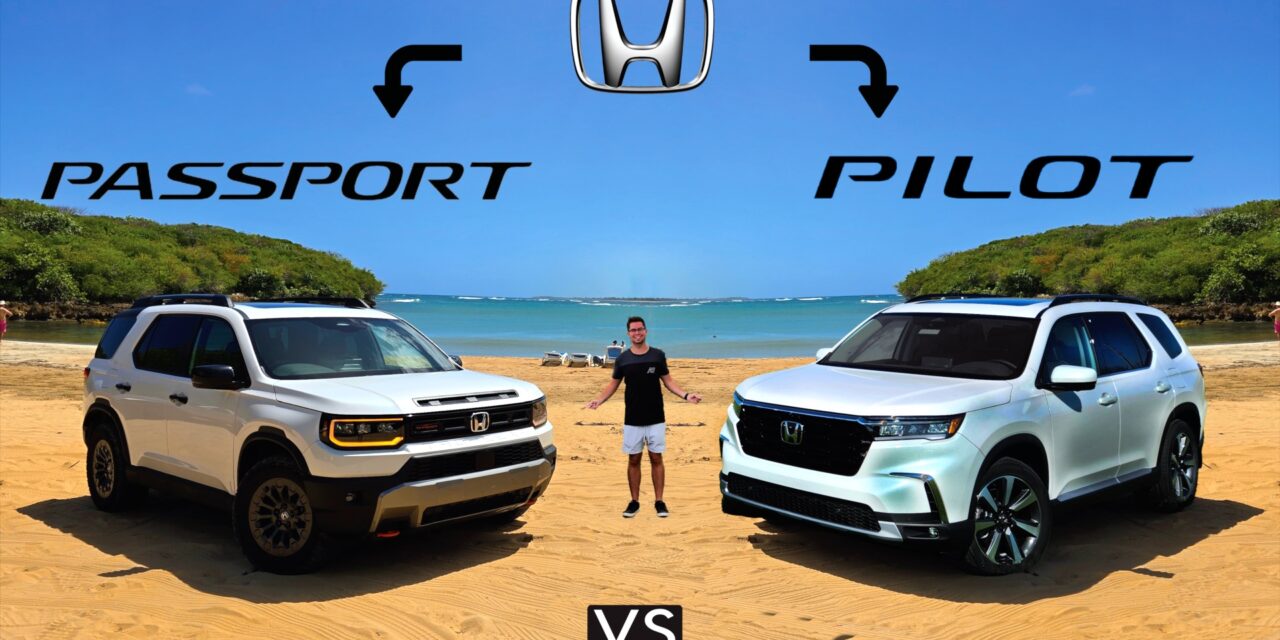
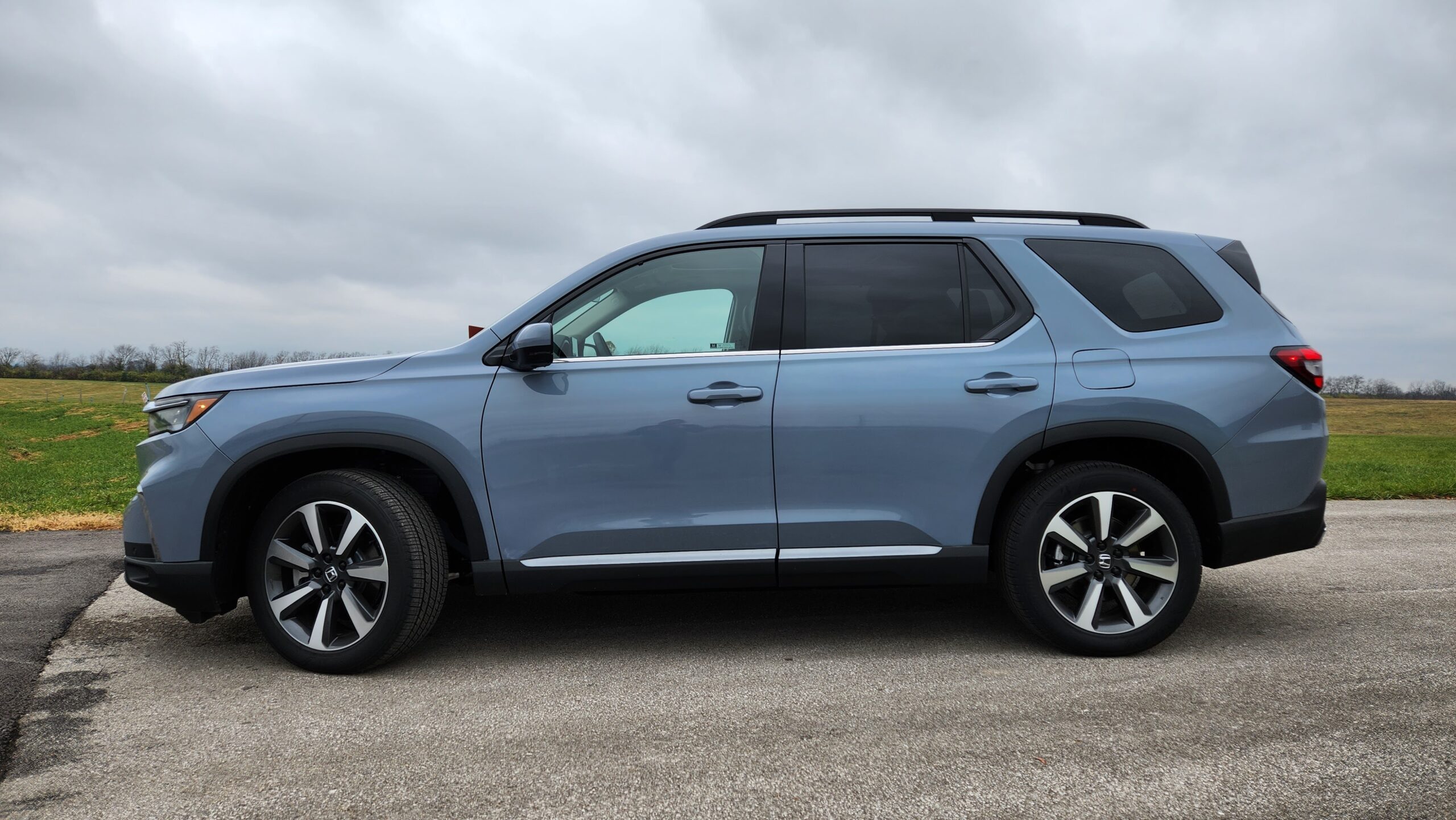
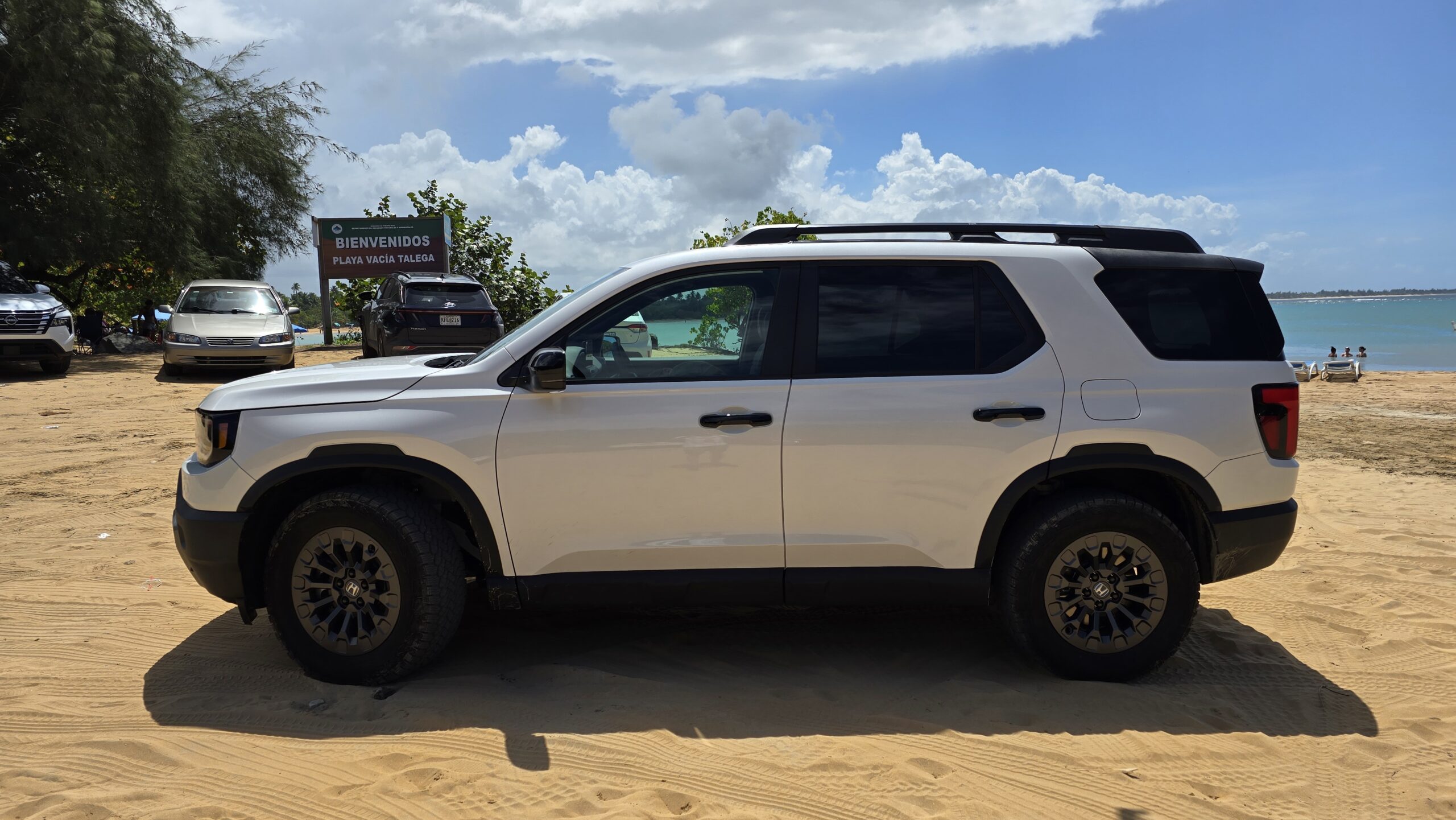
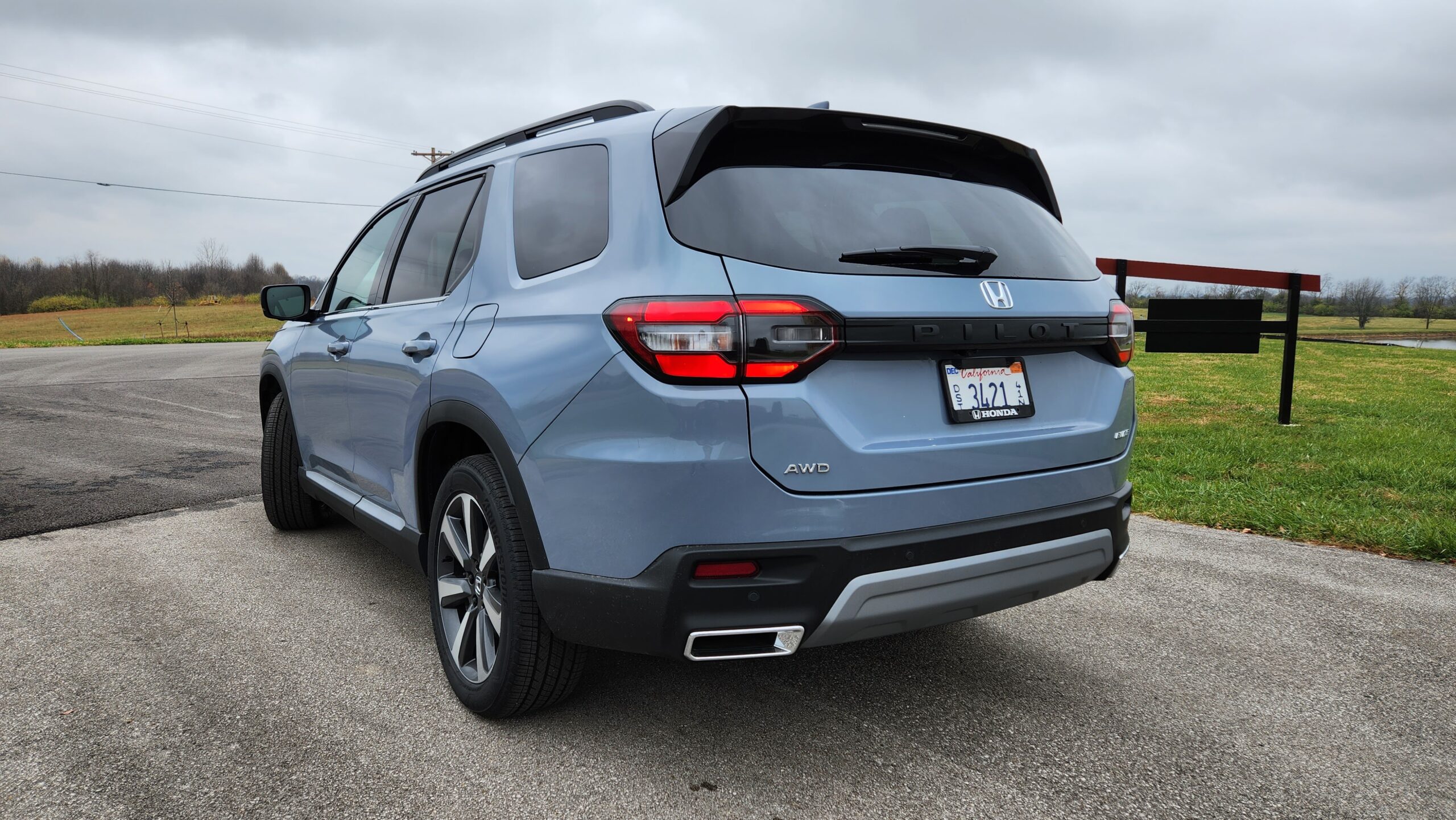
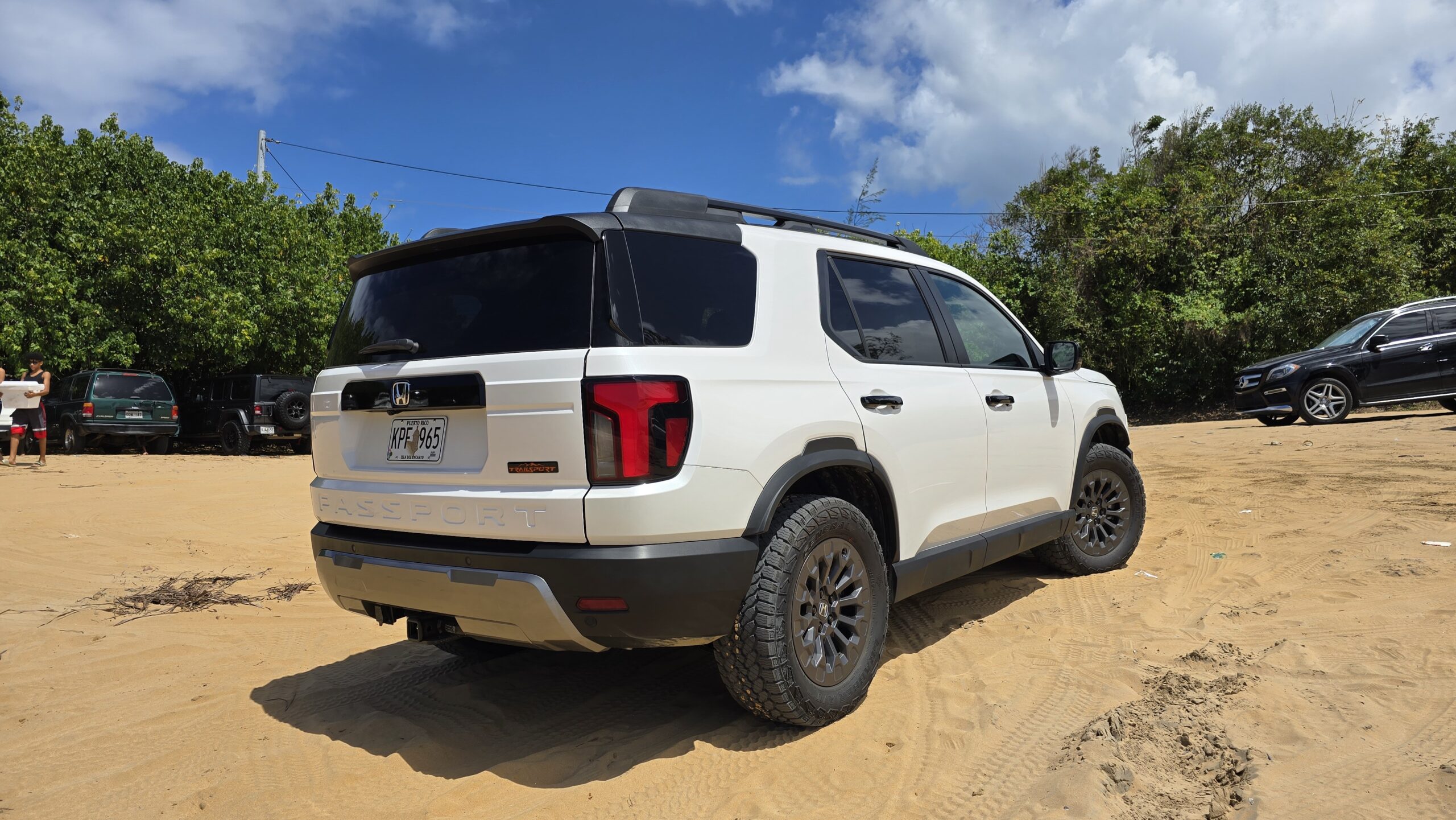


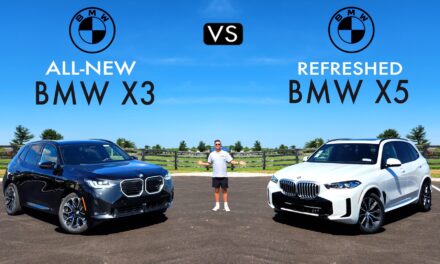
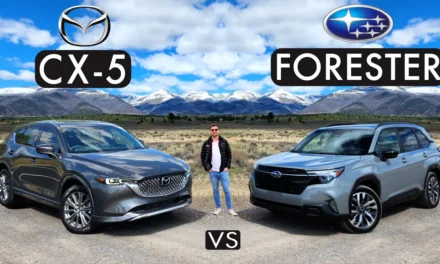






Recent Comments